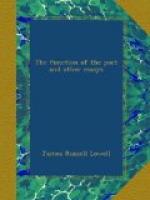In Shelley’s “Cenci,” on the other hand, we have an instance of the poet’s imagination giving away its own consciousness to the object contemplated, in this case an inanimate one.
Two miles on this side of the fort, the
road
Crosses a deep ravine; ’t is rough
and narrow,
And winds with short turns down the precipice;
And in its depth there is a mighty rock
Which has, from unimaginable years,
Sustained itself with terror and with
toil
Over a gulf, and with the agony
With which it clings seems slowly coming
down;
Even as a wretched soul hour after hour
Clings to the mass of life; yet clinging,
leans;
And leaning, makes more dark the dread
abyss
In which it fears to fall: beneath
this crag,
Huge as despair, as if in weariness,
The melancholy mountain yawns.
The hint of this Shelley took from a passage in the second act of Calderon’s “Purgatorio de San Patricio.”
No ves ese penasco que parece
Que se esta sustentando con trabajo,
Y con el ansia misma que padece
Ha tantos siglos que se viene abajo?
which, retaining the measure of the original, may be thus paraphrased:
Do you not see that rock there which appeareth
To hold itself up with a throe appalling,
And, through the very pang of what it
feareth,
So many ages hath been falling, falling?
You will observe that in the last instance quoted the poet substitutes his own impression of the thing for the thing itself; he forces his own consciousness upon it, and herein is the very root of all sentimentalism. Herein lies the fault of that subjective tendency whose excess is so lamented by Goethe and Schiller, and which is one of the main distinctions between ancient and modern poetry. I say in its excess, for there are moods of mind of which it is the natural and healthy expression. Thus Shakespeare in his ninety-seventh sonnet:
How like a winter hath my absence been
From thee, the pleasure of the fleeting
year!
What freezings have I felt, what dark
days seen,
What old December’s bareness everywhere!
And yet this time remov’d was summer’s
time.
It is only when it becomes a habit, instead of a mood of the mind, that it is a token of disease. Then it is properly dyspepsia, liver-complaint—what you will, but certainly not imagination as the handmaid of art. In that service she has two duties laid upon her: one as the plastic or shaping faculty, which gives form and proportion, and reduces the several parts of any work to an organic unity foreordained in that idea which is its germ of life; and the other as the realizing energy of thought which conceives clearly all the parts, not only in relation to the whole, but each in its several integrity and coherence.
We call the imagination the creative faculty. Assuming it to be so, in the one case it acts by deliberate forethought, in the other by intense sympathy—a sympathy which enables it to realize an Iago as happily as a Cordelia, a Caliban as a Prospero. There is a passage in Chaucer’s “House of Fame” which very prettily illustrates this latter function:




